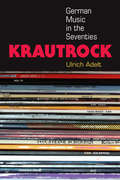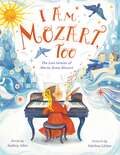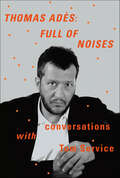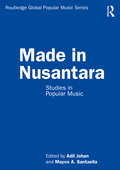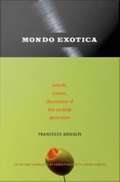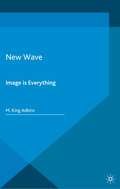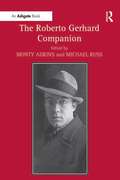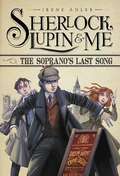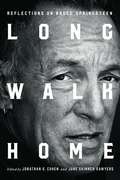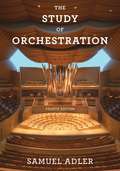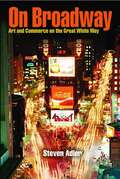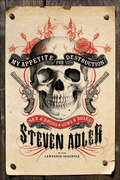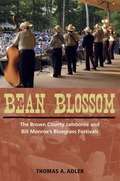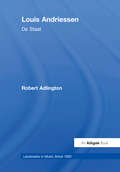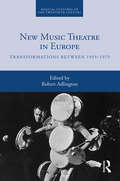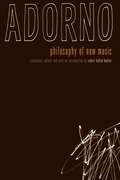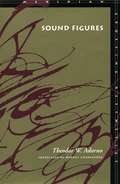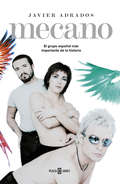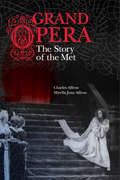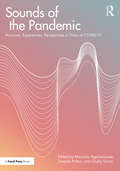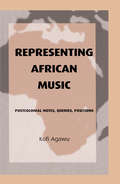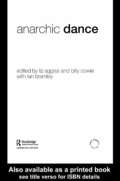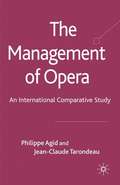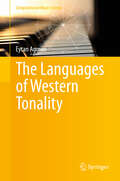- Table View
- List View
Krautrock: German Music in the Seventies
by Ulrich AdeltKrautrock is a catch-all term for the music of various white German rock groups of the 1970s that blended influences of African American and Anglo-American music with the experimental and electronic music of European composers. Groups such as Can, Popol Vuh, Faust, and Tangerine Dream arose out of the German student movement of 1968 and connected leftist political activism with experimental rock music and, later, electronic sounds. Since the 1970s, American and British popular genres such as indie, post-rock, techno, and hip-hop have drawn heavily on krautrock, ironically reversing a flow of influence krautrock originally set out to disrupt. Among other topics, individual chapters of the book focus on the redefinition of German identity in the music of Kraftwerk, Can, and Neu!; on community and conflict in the music of Amon Düül, Faust, and Ton Steine Scherben; on "cosmic music" and New Age; and on Donna Summer's and David Bowie's connections to Germany. Rather than providing a purely musicological or historical account, Krautrock discusses the music as being constructed through performance and articulated through various forms of expressive culture, including communal living, spirituality, and sound.
I Am Mozart, Too: The Lost Genius of Maria Anna Mozart
by Audrey AdesTo everyone who has heard of my famous younger brother but has never heard of me.I Am Mozart, Too is a picture book biography about Wolfgang's older sister, Maria Anna Mozart, who was a child prodigy and a secret composer, perfect for Women's History Month.Nannerl and Wolfie love playing the harpsichord together. They are so talented, the Mozart siblings perform all over Europe for packed audiences in beautiful concert halls. Even Empress Maria Theresa requests that they stop in Vienna to play especially for her.But then Nannerl does something naughty: She starts writing music of her own. Papa fumes. Girls are not allowed to compose! Girls belong behind the curtain.While Wolfie’s solo career takes flight, Nannerl must settle for a life offstage. But it doesn’t stop her from pursuing her dreams in secret.With vivid, sweeping art by Adelina Lirius, author Audrey Ades tells the powerful true story of a talented, ambitious girl who has been hidden from history—a girl who was and always will be a genius, too.
Thomas Adès: Conversations With Tom Service
by Thomas Adès Tom ServiceComposer, conductor, and pianist, Thomas Adès is one of the most diversely talented musical figures of his generation. His music is performed by great opera companies, symphony orchestras, chamber groups, and music festivals throughout the world. But Adès has resisted public discussion of the creative process behind his musical compositions. Until now, the interior experience that has fired the spectrum of his work—from his first opera, Powder Her Face, to his masterpiece The Tempest and his acclaimed orchestral works Asyla and Tevot—has largely remained unexplained. Here, in spirited, intimate, and, at times, contentious conversations with the distinguished music critic Tom Service, Adès opens up about his work. "For Adès, whose literary and artistic sensibilities are nearly as refined and virtuosic as his musical instincts," writes Service, "inhabiting the different territory of words rather than notes offers a chance to search out new creative correspondences, to open doors—a phrase he often uses—into new ways of thinking in and about music."The phrase "full of noises," from Caliban's speech in The Tempest, refers both to the sounds "swirling around" Adès's head that are transmuted into music and to the vast array of his musical influences—from Sephardic folk music, to 1980s electronica, to Adès's passion for Beethoven and Janácek and his equally visceral dislike of Wagner. It also suggests "the creative friction" essential to any authentic dialogue. As readers of these "wilfully brilliant" conversations will quickly discover, Thomas Adès: Full of Noises brings us into the "revelatory kaleidoscope" of Adès's world.
Made in Nusantara: Studies in Popular Music (Routledge Global Popular Music Series)
by Adil Johan and Mayco A. SantaellaMade in Nusantara serves as a comprehensive introduction to the history, sociology, ethnography, and musicology of historical and contemporary popular music in maritime Southeast Asia. Each essay covers major figures, styles, and social contexts of genres of a popular nature in the Nusantara region including Malaysia, Indonesia, Brunei, Singapore, and the Philippines. Through a critical investigation of specific genres and their spaces of performance, production, and consumption, the volume is organised into four thematic areas: 1) issues in Nusantara popular music; 2) history; 3) artists and genres; and 4) national vs. local industries. Written by scholars working in the region, Made in Nusantara brings local perspectives to the history and analysis of popular music and critically considers conceptualisations developed in the West, rendering it an intriguing read for students and scholars of popular and global music.
Mondo Exotica: Sounds, Visions, Obsessions of the Cocktail Generation
by Francesco AdinolfiTiki torches, cocktails, la dolce vita, and the music that popularized them--Mondo Exotica offers a behind-the-scenes look at the sounds and obsessions of the Space Age and Cold War period as well as the renewed interest in them evident in contemporary music and design. The music journalist and radio host Francesco Adinolfi provides extraordinary detail about artists, songs, albums, and soundtracks, while also presenting an incisive analysis of the ethnic and cultural stereotypes embodied in exotica and related genres. In this encyclopedic account of films, books, TV programs, mixed drinks, and above all music, he balances a respect for exotica's artistic innovations with a critical assessment of what its popularity says about postwar society in the United States and Europe, and what its revival implies today. Adinolfi interviewed a number of exotica greats, and Mondo Exotica incorporates material from his interviews with Martin Denny, Esquivel, the Italian film composers Piero Piccioni and Piero Umiliani, and others. It begins with an extended look at the postwar popularity of exotica in the United States. Adinolfi describes how American bachelors and suburbanites embraced the Polynesian god Tiki as a symbol of escape and sexual liberation; how Les Baxter's album Ritual of the Savage (1951) ushered in the exotica music craze; and how Martin Denny's Exotica built on that craze, hitting number one in 1957. Adinolfi chronicles the popularity of performers from Yma Sumac, "the Peruvian Nightingale," to Esquivel, who was described by Variety as "the Mexican Duke Ellington," to the chanteuses Eartha Kitt, Julie London, and Ann-Margret. He explores exotica's many sub-genres, including mood music, crime jazz, and spy music. Turning to Italy, he reconstructs the postwar years of la dolce vita, explaining how budget spy films, spaghetti westerns, soft-core porn movies, and other genres demonstrated an attraction to the foreign. Mondo Exotica includes a discography of albums, compilations, and remixes.
New Wave: Image is Everything (Pop Music, Culture and Identity)
by K. AdkinsNew Wave: Image is Everything traces the evolution of the often neglected pop music genre, new wave. Using artists from Elvis Costello to Cyndi Lauper as illustrations, the book argues that new wave was among the first flowerings of postmodern theory in popular culture.
New Wave
by M. King AdkinsWhile punk often receives more scholarly attention, new wave marks an even more important turning point in music history, one that continues to resonate in popular culture today. New Wave: Image is Everything traces the evolution of this often neglected pop genre by focusing on an eclectic collection of artists from Elvis Costello to Cyndi Lauper, Devo to Duran Duran. In addition, it explores a number of important historical moments, such as MTV's first broadcast, and how these moments helped to shape our world. The book also argues that new wave was among the first flowerings of postmodern theory in popular culture, and in doing so it not only provides a history of new wave, but also helps explain the basic principles of postmodernism by putting them in easy to understand terms.
The Roberto Gerhard Companion (Routledge Music Companions)
by Monty AdkinsMore than forty years after the composer's death, the music of Roberto Gerhard (1896-1970) continues to be recorded and performed and to attract international scholarly interest. The Roberto Gerhard Companion is the first full length scholarly work on this composer noted for his sharp intellect and original, exploring mind. This book builds on the outcomes of two recent international conferences and includes contributions by scholars from Spain, the USA and UK. The essays collected here explore themes and trends within Gerhard’s work, using individual or groups of works as case studies. Among the themes presented are the way Gerhard’s work was shaped by his Catalan heritage, his education under Pedrell and Schoenberg, and his very individual reaction to the latter’s teaching and methods, notably Gerhard’s very distinctive approach to serialism. The influence of these and other cultural and literary figures is an important underlying theme that ties essays together. Exiled from Catalonia from 1939, Gerhard spent the remainder of his life in Cambridge, England, composing a string of often ground-breaking compositions, notably the symphonies and concertos composed in the 1950s and 1960s. A particular focus in this book is Gerhard's electronic music. He was a pioneer in this genre and the book will contain the first rigorous studies of this music as well as the first accurate catalogue of this electronic output. His ground-breaking output of incidental music for radio and the stage is also given detailed consideration.
The Soprano's Last Song
by Irene AdlerIrene Adler, Sherlock Holmes, and Arsene Lupin plan to reunite in London, but Lupin doesn't show up ... his father, Theophraste, has been arrested for murder.
Long Walk Home: Reflections on Bruce Springsteen
by Natalie Adler Eric Alterman Regina Barreca Nancy Bishop Dermot Bolger Peter Ames Carlin Jefferson Cowie Jim Cullen Joel Dinerstein Gillian G. Gaar Martyn Joseph Deepa Iyer Greil Marcus Louis Masur Paul Muldoon Lauren Onkey Richard Russo A. O. Scott Colleen Sheehy Wesley Stace Frank Stefanko Irwin Streight Wayne Swan David L. Ulin Elijah Wald Daniel Wolff Kenneth WomackBruce Springsteen might be the quintessential American rock musician but his songs have resonated with fans from all walks of life and from all over the world. This unique collection features reflections from a diverse array of writers who explain what Springsteen means to them and describe how they have been moved, shaped, and challenged by his music. Contributors to Long Walk Home include novelists like Richard Russo, rock critics like Greil Marcus and Gillian Gaar, and other noted Springsteen scholars and fans such as A. O. Scott, Peter Ames Carlin, and Paul Muldoon. They reveal how Springsteen’s albums served as the soundtrack to their lives while also exploring the meaning of his music and the lessons it offers its listeners. The stories in this collection range from the tale of how “Growin’ Up” helped a lonely Indian girl adjust to life in the American South to the saga of a group of young Australians who turned to Born to Run to cope with their country’s 1975 constitutional crisis. These essays examine the big questions at the heart of Springsteen’s music, demonstrating the ways his songs have resonated for millions of listeners for nearly five decades. Commemorating the Boss’s seventieth birthday, Long Walk Home explores Springsteen’s legacy and provides a stirring set of testimonials that illustrate why his music matters.
The Study Of Orchestration
by Samuel AdlerThe third edition of this high successful orchestration text follows the approach established in its innovative predecessor: Learning orchestration is best achieved through familiarity with the orchestral literature; this familiarity is most effectively accomplished from the music notation in combination with the recorded sound. The text has been revised to reflect the most informed reactions to the first and second editions, as well as Professor Adler's revisions. For comprehensiveness, conciseness, and contemporaneity, The Study of Orchestration remains without peer.
On Broadway: Art and Commerce on the Great White Way
by Steven AdlerAt a critical, transitional moment in the history of Broadway—and, by extension, of American theatre itself—former Broadway stage manager Steven Adlerenlists insider perspectives from sixty-six practitioners and artists to chronicle the recent past and glimpse the near future of the Great White Way. From marquee names to behind-the-scenes power brokers, Adler has assembled a distinctly knowledgeable cast of theatre’s elite, including Stephen Sondheim, Arthur Laurents, Des McAnuff, Frank Rich, Robin Wagner, Rocco Landesman, Robert Longbottom, Todd Haimes, Bernard Gersten, and Alan Eisenberg. <P><P> On Broadway: Art and Commerce on the Great White Way spotlights the differing vantage points of performers, artists, writers, managers, producers, critics, lawyers, theatre owners, union leaders, city planners, and other influential players. Each details his or her firsthand account of the creative and economic forces that have wrought extraordinary changes in the way Broadway theatre is conceived, produced, marketed, and executed. Once the paramount site of American theatre, Broadway today is becoming a tourist-driven, family-friendly, middle-class entertainment oasis in Midtown, an enterprise inextricably bound to the larger mosaic of national and international professional theatre. <P><P> Accounting for this transformation and presaging Broadway’s identity for the twenty-first century, Adler and his interviewees assess the impact of the advent of corporate producers, the ascendance of not-for-profit theatres on Broadway, and the growing interdependence between regional and Broadway productions. Also critiqued are the important roles of the radical urban redevelopment staged in Times Square and the changing demographics and appetites of contemporary theatre audiences in New York and around the globe. <P><P> Actors and administrators, performers and producers, theatre students and theatregoers will all benefit from the perceptive insights in this authoritative account of theatre making for the new millennium.
My Appetite for Destruction: Sex & Drugs & Guns N' Roses
by Steven Adler Lawrence J. SpagnolaFrom Steven Adler, the original drummer for Guns N’ Roses, comes My Appetite for Destruction, the inside story of GNR. Offering a different perspective from the bestselling Slash, Adler chronicles his life with the band, and own intense struggle with addiction, as seen on Dr. Drew’s Celebrity Rehab and Sober House.
Bean Blossom: The Brown County Jamboree and Bill Monroe's Bluegrass Festivals
by Thomas A. AdlerBean Blossom, Indiana--near Brown County State Park and the artist-colony town of Nashville, Indiana--is home to the annual Bean Blossom Bluegrass Festival, founded in 1967 by Bill Monroe, the father of bluegrass. Widely recognized as the oldest continuously running bluegrass music festival in the world, this June festival's roots run back to late 1951, when Monroe purchased the Brown County Jamboree, a live weekly country music show presented between April and November each year. Over the years, Monroe's festival featured the top performers in bluegrass music, including Jimmy Martin, Lester Flatt, Earl Scruggs, the Goins Brothers, the Stanley Brothers, and many more. Thomas A. Adler's history of Bean Blossom traces the long and colorful life of the Brown County Jamboree and Bill Monroe's Bluegrass Festival. Adler discusses the development of bluegrass music, the many personalities involved in the bluegrass music scene, the interplay of local, regional, and national interests, and the meaning of this venue to the music's many performers--both professional and amateur--and its legions of fans.
Louis Andriessen: De Staat (Landmarks In Music Since 1950 Ser.)
by Robert AdlingtonLouis Andriessen is one of the foremost composers in the world today. His music, with its distinctive blend of jazz, minimalism, Stravinsky and the European avant-garde, has attracted wide audiences internationally and made him a sought-after teacher among younger generations of composers. De Staat ('The Republic') brought Andriessen to international attention in 1976, and it remains his best-known work. This book is the first extended, single-author study of Andriessen in any language. It opens with a detailed account of Andriessen's involvement in the political upheavals of the 1960s and 1970s which formed the basis for his later views on instrumentation and musical style. The following chapters assess the principal influences on his music and the musical structure of De Staat. The book closes with an extensive discussion of the meaning of De Staat in the light of the composer's firmly held socio-political views. The downloadable resources include a thrilling live recording of De Staat from the 1978 Holland Festival, plus two earlier works not previously commercially available on compact disc - De Volharding and Il Principe.
New Music Theatre in Europe: Transformations between 1955-1975 (Musical Cultures of the Twentieth Century)
by Robert AdlingtonBetween 1955 and 1975 music theatre became a central preoccupation for European composers digesting the consequences of the revolutionary experiments in musical language that followed the end of the Second World War. The ‘new music theatre’ wrought multiple, significant transformations, serving as a crucible for the experimental rethinking of theatrical traditions, artistic genres, the conventions of performance, and the composer’s relation to society. This volume brings together leading specialists from across Europe to offer a new appraisal of the genre. It is structured according to six themes that investigate: the relation of new music theatre to earlier and contemporaneous theories of drama; the use of new technologies; the relation of new music theatre to progressive politics; the role of new venues and environments; the advancement of new conceptions of the performer; and the challenges that new music theatre lays down for music analysis. Contributing authors address canonical works by composers such as Berio, Birtwistle, Henze, Kagel, Ligeti, Nono, and Zimmermann, but also expand the field to figures and artistic developments not regularly represented in existing music histories. Particular attention is given to new music theatre as a site of intense exchange – between practitioners of different art forms, across national borders, and with diverse mediating institutions.
Philosophy of New Music
by Theodor W. AdornoAn indispensable key to Adorno&’s influential oeuvre—now in paperbackIn 1949, Theodor W. Adorno&’s Philosophy of New Music was published, coinciding with the prominent philosopher&’s return to a devastated Europe after his exile in the United States. Intensely polemical from its first publication, every aspect of this work was met with extreme reactions, from stark dismissal to outrage. Even Arnold Schoenberg reviled it. Despite the controversy, Philosophy of New Music became highly regarded and widely read among musicians, scholars, and social philosophers. Marking a major turning point in his musicological philosophy, Adorno located a critique of musical reproduction as internal to composition, rather than a matter of musical performance. Consisting of two distinct essays, &“Schoenberg and Progress&” and &“Stravinsky and Reaction,&” Philosophy of New Music poses the musical extremes in which Adorno perceived the struggle for the cultural future of Europe: between human emancipation and barbarism, between the compositional techniques and achievements of Schoenberg and Stravinsky. In this translation, which is accompanied by an extensive introduction by distinguished translator Robert Hullot-Kentor, Philosophy of New Music emerges as an essential guide to the whole of Adorno's oeuvre.
Sound Figures (Meridian: Crossing Aesthetics)
by Theodor W. AdornoTheodor Adorno is one of this century's most influential thinkers in the areas of social theory, philosophy, aesthetics, and music. Throughout the essays in this book, all of which concern musical matters, he displays an astonishing range of cultural reference, demonstrating that music is invariably social, political, even ethical. Adorno's insistence on the social character of aesthetic works will come as no surprise to those familiar with his writings, although many may be surprised by the volume's somewhat colloquial tone. This colloquialism, in dialogue with Adorno's unceasing rigor, stems from the occasional sources of many of the essays, mainly public lectures and radio addresses. As such, this volume represents an important and, for English-language readers, largely unfamiliar side to Adorno. His arguments move more quickly than in his more formal and extended musicological works, and the writing is much more accessible and generous than his usually dense and frequently opaque prose. This volume includes essays on prominent figures in music (Alban Berg, Anton von Webern, Arturo Toscanini), compositional technique (the prehistory of the twelve-tone row, the function of counterpoint in new music), and the larger questions of musical sociology for which Adorno is most famous, including the relation of interpretation to audience, the ideological function of opera, and the historical meaning of musical technique. The essay on the sociology of music, for example, represents an early statement of what would soon become trademark principles of his mode of musical analysis, serving as a catalyst for his famous study Introduction to the Sociology of Music. Some forty years after most of these essays were written, they remain fresh and relevant. In part, this is because Adorno's method has only recently begun to make substantial inroads into Anglo-American musicology. And the interdisciplinary nature of his thought provides a precursor for today's interdisciplinary studies.
Mecano: El grupo español más importante de la historia
by Javier AdradosLa biografía definitiva y autorizada de Mecano. Hace cuarenta años que un adolescente llamado José María Cano le pidió a su hermano, Nacho, y a su novia, Ana, que le acompañaran en sus conciertos como cantautor por colegios mayores y bares de Madrid. En ese ambiente conocieron al productor musical Miguel Ángel Arenas, el "Capi", quien les recomendó que la voz principal fuera la de Ana y les consiguió un contrato con CBS. Así nació Mecano, sin imaginar que se convertiría en el fenómeno pop más importante de nuestra historia. Pero aún hay muchas preguntas sin responder sobre el grupo que ha vendido más de veinticinco millones de discos en todo el mundo. ¿Cómo se construyó Mecano? ¿Por qué provocaron esa feroz animadversión en los grupos de la movida madrileña? ¿Qué causó las tensiones entre los miembros de la banda que les llevaron a disolverse? Esta biografía es la respuesta a todos los interrogantes, un recorrido por la historia del grupo que aun a pesar de su desaparición, no ha dejado de sonar en ninguna de las emisoras de radio. La música de Mecano es presente
Grand Opera
by Mirella Jona Affron Charles AffronThe Metropolitan has stood among the grandest of opera companies since its birth in 1883. Tracing the offstage/onstage workings of this famed New York institution, Charles Affron and Mirella Jona Affron tell how the Met became and remains a powerful actor on the global cultural scene. In this first new history of the company in thirty years, each of the chronologically sequenced chapters surveys a composer or a slice of the repertoire and brings to life dominant personalities and memorable performances of the time. From the opening night Faust to the recent controversial production of Wagner's "Ring," Grand Opera is a remarkable account of management and audience response to the push and pull of tradition and reinvention. Spanning the decades between the Gilded Age and the age of new media, this story of the Met concludes by tipping its hat to the hugely successful "Live in HD" simulcasts and other twenty-first-century innovations. Grand Opera's appeal extends far beyond the large circle of opera enthusiasts. Drawing on unpublished documents from the Metropolitan Opera Archives, reviews, recordings, and much more, this richly detailed book looks at the Met in the broad context of national and international issues and events.
Sounds of the Pandemic: Accounts, Experiences, Perspectives in Times of COVID-19
by Maurizio Agamennone Daniele Palma Giulia SarnoSounds of the Pandemic offers one of the first critical analyses of the changes in sonic environments, artistic practice, and listening behaviour caused by the Coronavirus outbreak. This multifaceted collection provides a detailed picture of a wide array of phenomena related to sound and music, including soundscapes, music production, music performance, and mediatisation processes in the context of COVID-19. It represents a first step to understanding how the pandemic and its by-products affected sound domains in terms of experiences and practices, representations, collective imaginaries, and socio-political manipulations. This book is essential reading for students, researchers, and practitioners working in the realms of music production and performance, musicology and ethnomusicology, sound studies, and media and cultural studies.
Representing African Music: Postcolonial Notes, Queries, Positions
by Kofi AgawuThe aim of this book is to stimulate debate by offering a critique of discourse about African music. Who writes about African music, how, and why? What assumptions and prejudices influence the presentation of ethnographic data? Even the term "African music" suggests there is an agreed-upon meaning, but African music signifies differently to different people. This book also poses the question then, "What is African music?" Agawu offers a new and provocative look at the history of African music scholarship that will resonate with students of ethnomusicology and post-colonial studies. He offers an alternative "Afro-centric" means of understanding African music, and in doing so, illuminates a different mode of creativity beyond the usual provenance of Western criticism. This book will undoubtedly inspire heated debate--and new thinking--among musicologists, cultural theorists, and post-colonial thinkers. Also includes 15 musical examples.
Anarchic Dance
by Liz Aggiss Billy Cowie Ian BramleyLiz Aggiss and Billy Cowie, known collectively as Divas Dance Theatre, are renowned for their highly visual, interdisciplinary brand of dance performance that incorporates elements of theatre, film, opera, poetry and vaudevillian humour. Anarchic Dance, consisting of a book and DVD-Rom, is a visual and textual record of their boundary-shattering performance work. The DVD-Rom features extracts from Aggiss and Cowie's work, including the highly-acclaimed dance film Motion Control (premiered on BBC2 in 2002), rare video footage of their punk-comic live performances as The Wild Wigglers and reconstructions of Aggiss's solo performance in Grotesque Dancer. These films are cross-referenced in the book, allowing readers to match performance and commentary as Aggiss and Cowie invite a broad range of writers to examine their live performance and dance screen practice through analysis, theory, discussion and personal response. Extensively illustrated with black and white and colour photographs Anarchic Dance, provides a comprehensive investigation into Cowie and Aggiss’s collaborative partnership and demonstrates a range of exciting approaches through which dance performance can be engaged critically.
The Management of Opera
by Philippe Agid Jean-Claude TarondeauThis book presents the current and future issues facing opera houses and opera companies. Problems in different environments need different solutions. In particular, it opposes the American method of managing cultural institutions, preferring a European one where public support and funds plays a major role.
The Languages of Western Tonality
by Eytan AgmonTonal music, from a historical perspective, is far from homogenous; yet an enduring feature is a background "diatonic" system of exactly seven notes orderable cyclically by fifth. What is the source of the durability of the diatonic system, the octave of which is representable in terms of two particular integers, namely 12 and 7? And how is this durability consistent with the equally remarkable variety of musical styles -- or languages -- that the history of Western tonal music has taught us exist? This book is an attempt to answer these questions. Using mathematical tools to describe and explain the Western musical system as a highly sophisticated communication system, this theoretical, historical, and cognitive study is unprecedented in scope and depth. The author engages in intense dialogue with 1000 years of music-theoretical thinking, offering answers to some of the most enduring questions concerning Western tonality. The book is divided into two main parts, both governed by the communicative premise. Part I studies proto-tonality, the background system of notes prior to the selection of a privileged note known as "final. " After some preliminaries that concern consonance and chromaticism, Part II begins with the notion "mode. " A mode is "dyadic" or "triadic," depending on its "nucleus. " Further, a "key" is a special type of "semi-key" which is a special type of mode. Different combinations of these categories account for tonal variety. Ninth-century music, for example, is a tonal language of dyadic modes, while seventeenth-century music is a language of triadic semi-keys. While portions of the book are characterized by abstraction and formal rigor, more suitable for expert readers, it will also be of value to anyone intrigued by the tonal phenomenon at large, including music theorists, musicologists, and music-cognition researchers. The content is supported by a general index, a list of definitions, a list of notation used, and two appendices providing the basic mathematical background.
